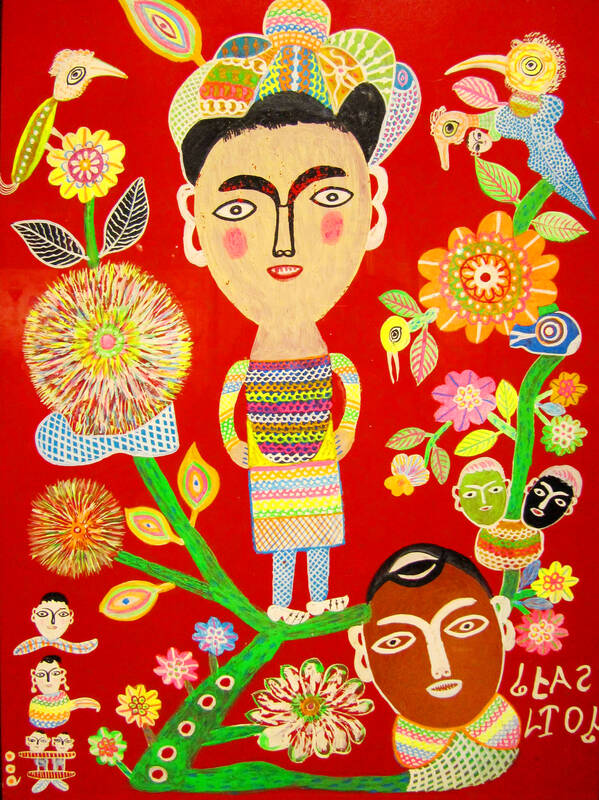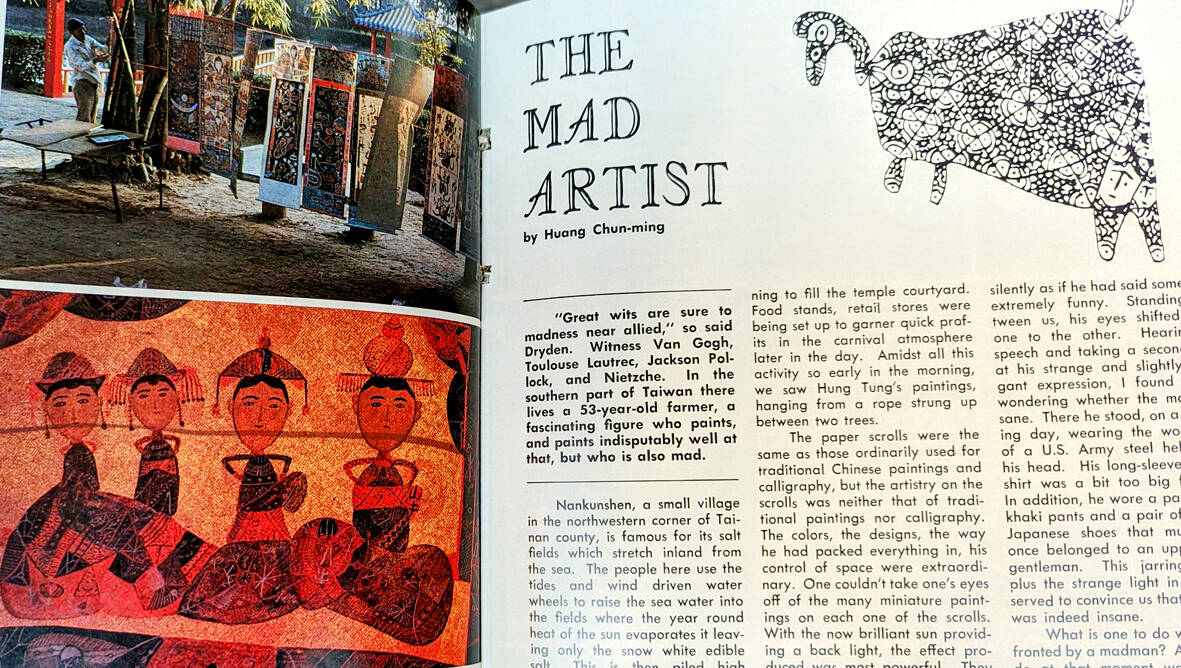Feb. 20 to Feb. 26
Just a few years removed from the peak of his fame, Hung Tung (洪通) lived alone in a dilapidated house in rural Tainan in the 1980s, working on his art and subsisting mostly on sweet soymilk. His family had moved to Tainan City, but he refused to join them.
Neighbors were mostly used to this peculiar old man, who seemed to live in his own world and rarely interacted with others. Even though he barely had enough to eat, he still refused to sell his paintings. Several months after the death of his wife, Hung passed away on Feb. 23, 1987.

Photo courtesy of Hung Shih-pao
At his posthumous retrospective, his paintings sold for as little as NT$30,000 — quite meager for an artist who was once the talk of the nation. Art collector Chou Yu (周渝) urged Hung’s son to stop selling the paintings, telling him that they would fetch much higher prices in the future.
Chou was right. A second “Hung Tung craze” swept the art world in the 1990s, with one piece fetching NT$3.6 million in 1996. On the ninth anniversary of his death, Hung’s paintings were exhibited overseas for the first time -- first in New York City, then at the Asian Arts & Cultural Center at Towson University in Maryland.
Ever averse to publicity, Hung probably wouldn’t have liked it if he were alive.

Photo: Hsi Yen-hsia, Taipei Times
MIDLIFE CRISIS?
Nicknamed the “Amateur Painter” and “Mad Artist,” Hung was born in 1920 in Kunchiang Village (鯤江) in rural Tainan. It was a barren area, and the illiterate Hung scraped out a living as a fisherman, bricklayer, fishmonger, candle vendor, construction worker and spirit medium.
Soon after he turned 50, Hung’s wife suddenly found him kneeling in front of her, begging her to let him stop working and focus on painting. She declined twice, but finally relented. He clearly remembers that day: it was Nov. 4, 1969.

Photo: Han Cheung, Taipei Times
“My life has been filled with more hardships than happiness,” Hung tells writer Chang Yin (常茵) in an interview. “After I turned 50, I started to experience suffocating feelings of despondence that made me feel sad and mournful. I needed to get that feeling off my chest, so I picked up a stone and started drawing on the ground and the walls. I was engrossed and soon got the hang of it.”
“Drawing was the only way for me to forget the poverty and suffering of everyday life. It made me happy on a spiritual level,” he adds.
Hung locked himself in his room, painting day and night. The villagers looked down on his behavior, convinced that he had gone nuts. His cousins called him a “useless person” to his face, while others said that he was possessed by an evil spirit.
When he did venture out, it was often to see exhibits and to learn from professional artists. Tseng Pei-yao’s (曾培堯) recalls in a Lion Art Monthly (雄獅美術) article seeing a depressed-looking old man from the countryside at his doorstep one day. He had a large roll of drawings that he claimed were made by his farmer friend, and wanted Tseng’s opinion on them.
“When I told him my thoughts, he seemed happy, and said that I was the first person to praise these works. He said others told him they were worthless and worse than a child’s scribblings,” Tseng writes.
Hung insisted that Tseng become his teacher. Between 1971 and 1973, Tseng gave Hung suggestions on material and subject matter, but claims to not have influenced his style.
DISCOVERY OF A MADMAN
In May 1972, the Wangye temple in nearby Nankunshen (南鯤鯓) held a photography contest. Hung put up about 20 of his pieces near the temple, which caught the attention of an Echo of Things Chinese (漢聲) magazine team who was there to cover the deity’s birthday ceremony.
The English-language magazine published “The Mad Artist” in its July-August edition, describing Hung as a “fascinating figure who paints, and paints indisputably well at that, but who is also mad.”
“The colors, the designs, the way he had packed everything in, his control of space were extraordinary,” author Huang Chun-ming (黃春明) writes. “One couldn’t take one’s eyes off the miniature paintings on each one of the scrolls ... Small figures seemed to be winking at me, beckoning me to come closer, the flowers and shrubs even seemed to exude a sweet fragrance …”
Huang then spoke to Hung, who seemed surprised that they liked the art. Switching between “shy, humble” and “arrogant, self-satisfied” personas, the writer was convinced that Hung was a crazy genius. He found it hard to believe that Huang had never lived outside the village and had only been painting for three years.
The interview ended with Hung accusing them of stealing his paintings and threatening them with martial arts and black magic. They offered to buy some of the work, but Hung refused to sell.
News of the Mad Artist spread, leading to the craze known as the Hung Tung Phenomenon (洪通現象).
The frenzy reached a climax in 1976, when Hung had his first solo show at the US Information Agency office in Taipei. China Times (中國時報) devoted two-thirds of a page to him for six days in a row, leading other media to follow suit. Tens of thousands of visitors packed the venue for the entire two weeks of the exhibition.
However, Hung remained adamant on not selling his paintings and remained destitute. After three exhibitions in one year, he grew tired of the attention and returned home, becoming a recluse.
‘HUNG TUNG PHENOMENON’
Chen Chi-hsiung (陳吉雄) examines Hung’s meteoric rise and fall in Study on the Hung Tung Phenomenon (洪通現象之研究).
According to Chen, Hung’s rise coincided with the “nativist movement” (鄉土運動) in Taiwan, which began in the late 1960s as a pushback against the Western, modernist style that dominated the cultural scene. This sentiment for local culture and identity only grew in the 1970s as the nation suffered setback after setback in the international arena.
“These events sparked a strong sense of crisis and self-awareness among Taiwanese society and the cultural community as they pondered Taiwan’s fate,” Chen writes.
This period saw the rise of Taiwan-born realist writers, as well as ventures by Western-educated musicians to rural areas to “discover” traditional folk music. The fine arts world, however, was still lacking in nativist content by the early 1970s, and Hung’s humble background and reputation as an untrained genius was the perfect embodiment of the sentiment.
“His success was a product of the times,” Chen writes. “Due to the [media frenzy], viewing his art became a trendy thing to do for the masses … as popular culture is often disposable and ephemeral, it’s not hard to understand why Hung Tung’s stardom rose as quickly as it fell.”
Chen adds that most people saw Hung as some sort of fairy-tale figure with a fascinating backstory instead of purely as an artist. They visited his exhibit out of curiosity as if it were a spectacle, and as such, his art was quickly forgotten until it was “rediscovered” a decade later.
Taiwan in Time, a column about Taiwan’s history that is published every Sunday, spotlights important or interesting events around the nation that either have anniversaries this week or are tied to current events.

On April 26, The Lancet published a letter from two doctors at Taichung-based China Medical University Hospital (CMUH) warning that “Taiwan’s Health Care System is on the Brink of Collapse.” The authors said that “Years of policy inaction and mismanagement of resources have led to the National Health Insurance system operating under unsustainable conditions.” The pushback was immediate. Errors in the paper were quickly identified and publicized, to discredit the authors (the hospital apologized). CNA reported that CMUH said the letter described Taiwan in 2021 as having 62 nurses per 10,000 people, when the correct number was 78 nurses per 10,000

As we live longer, our risk of cognitive impairment is increasing. How can we delay the onset of symptoms? Do we have to give up every indulgence or can small changes make a difference? We asked neurologists for tips on how to keep our brains healthy for life. TAKE CARE OF YOUR HEALTH “All of the sensible things that apply to bodily health apply to brain health,” says Suzanne O’Sullivan, a consultant in neurology at the National Hospital for Neurology and Neurosurgery in London, and the author of The Age of Diagnosis. “When you’re 20, you can get away with absolute

May 5 to May 11 What started out as friction between Taiwanese students at Taichung First High School and a Japanese head cook escalated dramatically over the first two weeks of May 1927. It began on April 30 when the cook’s wife knew that lotus starch used in that night’s dinner had rat feces in it, but failed to inform staff until the meal was already prepared. The students believed that her silence was intentional, and filed a complaint. The school’s Japanese administrators sided with the cook’s family, dismissing the students as troublemakers and clamping down on their freedoms — with

As Donald Trump’s executive order in March led to the shuttering of Voice of America (VOA) — the global broadcaster whose roots date back to the fight against Nazi propaganda — he quickly attracted support from figures not used to aligning themselves with any US administration. Trump had ordered the US Agency for Global Media, the federal agency that funds VOA and other groups promoting independent journalism overseas, to be “eliminated to the maximum extent consistent with applicable law.” The decision suddenly halted programming in 49 languages to more than 425 million people. In Moscow, Margarita Simonyan, the hardline editor-in-chief of the